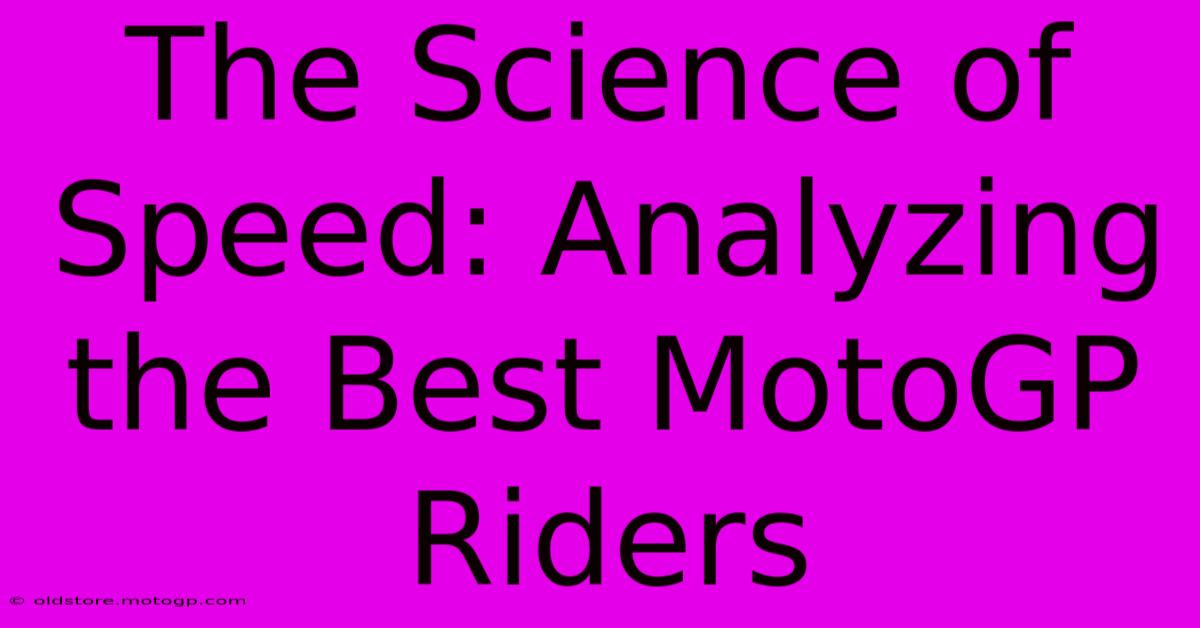The Science Of Speed: Analyzing The Best MotoGP Riders

Table of Contents
The Science of Speed: Analyzing the Best MotoGP Riders
MotoGP, the pinnacle of motorcycle road racing, showcases breathtaking speeds and incredible skill. But what separates the champions from the also-rans? It's not just about raw talent; it's a complex interplay of physical prowess, mental fortitude, and a deep understanding of the science behind speed. This article delves into the key factors that contribute to the success of the best MotoGP riders, exploring the science behind their incredible performances.
The Physics of MotoGP: More Than Just Horsepower
The speeds achieved in MotoGP are staggering, often exceeding 200 mph (320 km/h) on straights. This isn't solely down to the powerful engines; the physics involved are crucial. Understanding aerodynamics, tire grip, and the nuances of braking and cornering are paramount for achieving optimal lap times.
Aerodynamics: The Unsung Hero
Modern MotoGP bikes are incredibly aerodynamic. Fairings, winglets, and other aerodynamic aids minimize drag and maximize downforce, keeping the bike glued to the track at high speeds, especially through corners. The best riders understand how these elements affect their bikes at different speeds and lean angles, adjusting their riding style accordingly.
Tire Technology and Grip: The Crucial Connection
The connection between the tires and the track is vital. Tire grip dictates acceleration, braking, and cornering performance. Michelin, the sole tire supplier for MotoGP, provides cutting-edge tires with sophisticated compounds and construction. Top riders master the art of maximizing tire grip, understanding how tire temperature and pressure influence performance. They can feel subtle changes in grip and adapt their riding style to maintain optimal traction.
Braking and Cornering: Precision and Control
Braking and cornering techniques are refined to a science. Riders utilize sophisticated braking systems and employ techniques like trail braking to maintain control while maximizing deceleration. Cornering involves a precise balance of lean angle, throttle control, and body positioning. The best riders demonstrate exceptional precision and control, seemingly effortlessly navigating corners at incredible speeds.
The Human Element: Physical and Mental Fitness
While the technology plays a significant role, the human element is equally crucial. Top MotoGP riders are elite athletes, possessing exceptional physical and mental attributes.
Physical Fitness: Strength, Stamina, and Reaction Time
MotoGP riding is physically demanding. Riders need incredible strength, stamina, and reaction time to withstand the G-forces, maintain control, and react quickly to changing track conditions. Rigorous training regimes, including strength and conditioning, cardiovascular exercises, and specialized training like motocross, are vital for maintaining peak physical fitness.
Mental Fortitude: Focus, Discipline, and Adaptability
The mental aspect is equally crucial. Riders need immense focus, discipline, and adaptability to perform consistently at such a high level. Mental strength is essential for handling pressure, making quick decisions under extreme conditions, and recovering from setbacks. Many top riders employ mental conditioning techniques such as visualization and mindfulness to enhance their performance.
Data Analysis: The Key to Improvement
Modern MotoGP utilizes sophisticated data acquisition and analysis systems. Telemetry data provides valuable insights into various aspects of riding performance, allowing riders and teams to identify areas for improvement. Analyzing data on braking, acceleration, cornering speed, and tire temperatures helps optimize setup and riding techniques. This data-driven approach is crucial for maximizing performance and pushing the boundaries of speed.
The Future of Speed in MotoGP
MotoGP continues to evolve, with technological advancements constantly pushing the limits of speed and performance. Future developments in aerodynamics, electronics, and tire technology will likely lead to even faster lap times and more thrilling races. However, the human element will always remain crucial. The ability to master the science of speed, combined with exceptional physical and mental prowess, will continue to define the best MotoGP riders. The future of MotoGP is as exciting as its past, constantly pushing the boundaries of human potential and technological innovation.

Thank you for visiting our website wich cover about The Science Of Speed: Analyzing The Best MotoGP Riders. We hope the information provided has been useful to you. Feel free to contact us if you have any questions or need further assistance. See you next time and dont miss to bookmark.
Featured Posts
-
Sting F1 Where Innovation Meets The Track
Feb 20, 2025
-
The Ultimate Fans Guide To Cota Concerts
Feb 20, 2025
-
Austin F1 Map Find Your Way To The Action
Feb 20, 2025
-
Formula 1 Shuttle Austin Making Race Day Easier
Feb 20, 2025
-
Domination Or Upset Moto2 Standings 2025
Feb 20, 2025
